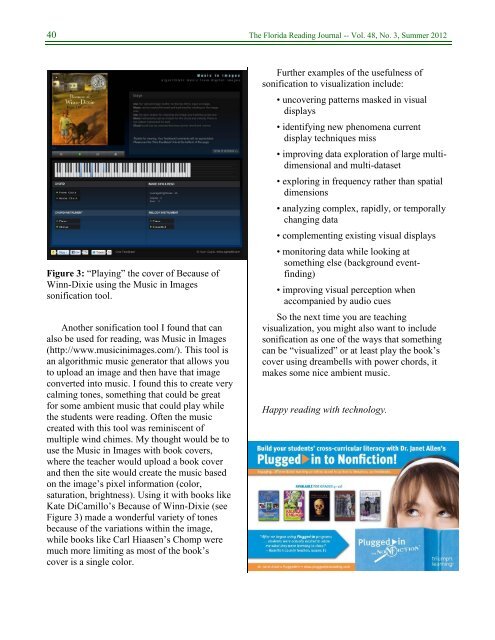PDF (Adobe Reader) - Florida Reading Association
PDF (Adobe Reader) - Florida Reading Association
PDF (Adobe Reader) - Florida Reading Association
Create successful ePaper yourself
Turn your PDF publications into a flip-book with our unique Google optimized e-Paper software.
40 The <strong>Florida</strong> <strong>Reading</strong> Journal -- Vol. 48, No. 3, Summer 2012<br />
Figure 3: “Playing” the cover of Because of<br />
Winn-Dixie using the Music in Images<br />
sonification tool.<br />
Another sonification tool I found that can<br />
also be used for reading, was Music in Images<br />
(http://www.musicinimages.com/). This tool is<br />
an algorithmic music generator that allows you<br />
to upload an image and then have that image<br />
converted into music. I found this to create very<br />
calming tones, something that could be great<br />
for some ambient music that could play while<br />
the students were reading. Often the music<br />
created with this tool was reminiscent of<br />
multiple wind chimes. My thought would be to<br />
use the Music in Images with book covers,<br />
where the teacher would upload a book cover<br />
and then the site would create the music based<br />
on the image‟s pixel information (color,<br />
saturation, brightness). Using it with books like<br />
Kate DiCamillo‟s Because of Winn-Dixie (see<br />
Figure 3) made a wonderful variety of tones<br />
because of the variations within the image,<br />
while books like Carl Hiaasen‟s Chomp were<br />
much more limiting as most of the book‟s<br />
cover is a single color.<br />
Further examples of the usefulness of<br />
sonification to visualization include:<br />
• uncovering patterns masked in visual<br />
displays<br />
• identifying new phenomena current<br />
display techniques miss<br />
• improving data exploration of large multidimensional<br />
and multi-dataset<br />
• exploring in frequency rather than spatial<br />
dimensions<br />
• analyzing complex, rapidly, or temporally<br />
changing data<br />
• complementing existing visual displays<br />
• monitoring data while looking at<br />
something else (background eventfinding)<br />
• improving visual perception when<br />
accompanied by audio cues<br />
So the next time you are teaching<br />
visualization, you might also want to include<br />
sonification as one of the ways that something<br />
can be “visualized” or at least play the book‟s<br />
cover using dreambells with power chords, it<br />
makes some nice ambient music.<br />
Happy reading with technology.



